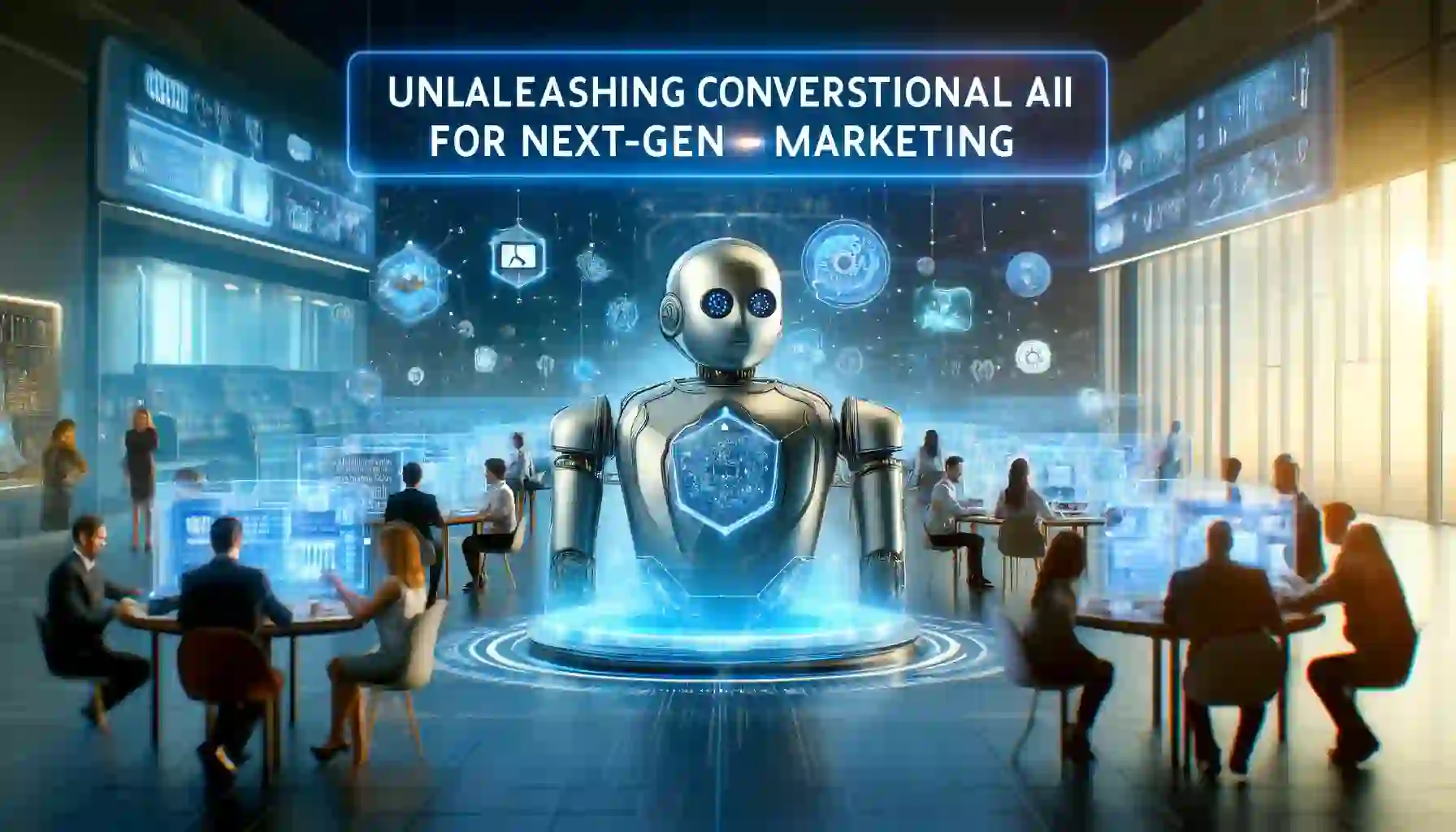Introduction
In today’s on-demand world, customers expect real-time, personalized engagement from brands across their preferred channels and touchpoints. However, traditional marketing vehicles like emails, advertisements, and websites often fall short in delivering truly instant, contextual experiences.
This is where conversational AI emerges as a game-changing solution for customer engagement. By leveraging advanced natural language interfaces powered by artificial intelligence, brands can converse with their audiences in more natural, human-like ways across voice and text-based conversational channels.
Conversational AI enables virtualized assistants, chatbots, and voicebots capable of understanding user intents, offering tailored recommendations, answering queries, guiding buyers through journeys, and even completing transactions – all through intuitive back-and-forth dialogue.
This unlocks new frontiers for low-friction, scalable engagement throughout the entire marketing lifecycle – from initial branding and discovery to nurturing, conversion, support and retention. In this blog, we’ll dive deep into the vast potential of applying conversational AI to supercharge marketing impact.
Understanding Conversational AI for Marketing
What is Conversational AI?
Conversational AI refers to technologies that enable human-like interactions between people and machines through spoken or written language across various messaging channels and modalities.
At its core, conversational AI solutions combine several key components:
Natural Language Processing (NLP): To understand the semantics and intent behind inputs like text messages or voice commands.
Natural Language Understanding (NLU): To interpret the full context around utterances and maintain coherent conversation flows.
Dialog Management: To determine appropriate responses by applying NLU insights to backend business logic and knowledge repositories.
Machine Learning: To continuously improve the NLP/NLU models by ingesting conversational data and signals over time.
Types of Conversational AI Systems
The most common implementations of conversational AI include:
Chatbots: Text-based conversational interfaces that communicate via messaging apps, websites, SMS, and other text channels.
Voicebots: Voice-activated interfaces that users interact with via spoken commands and natural language – such as virtual assistants like Alexa or Siri.
AI Assistants: Advanced bots with multimodal input/output capabilities (text, voice, visuals) that offer guided, task-oriented experiences.
Key Benefits of Conversational AI for Marketing
Some of the prime benefits driving adoption of conversational AI for marketing uses include:
24/7 Scalability: Ability to engage audiences instantly regardless of inquiry volume through automated self-service.
Personalized Experiences: Tailoring every conversation and recommendation to a user’s unique contexts, preferences, and real-time signals.
Low-Friction Interactions: Enabling seamless engagement through simple, natural language conversations users are comfortable with.
Lower Operating Costs: Deflecting routine queries, reducing support overhead, and freeing humans to focus on higher-value activities.
In essence, conversational AI empowers brands to add a responsive “human” face to their marketing and service efforts in a highly scalable manner.
Conversational Marketing Across the Customer Journey
Conversational AI solutions are incredibly versatile – applicable across all stages of the customer lifecycle from initial branding to retention and expansion. Let’s explore some key use cases:
1) Awareness & Discovery Stage
Chatbots for Website Engagement: Deploying chatbots on websites to greet new visitors, answer FAQs, share personalized content recommendations, capture new leads and qualify interest.
Voicebots for Voice Search: Optimizing website content and marketing assets to surface during relevant voice searches and enable hands-free interactions.
Social Media Chatbots: Engaging audiences in brand communities and social channels through friendly AI personas.
2) Nurturing & Conversion Stage
AI-Powered Ad Engagement: Conversational ads enabling prospects to ask questions, get recommendations, schedule meetings and make purchases right from ad units.
Personalized Sales Conversations: Automating tailored sales follow-up conversations and guided selling experiences at scale through chatbots or agents augmented by AI.
Conversational Ecommerce: Natural language-based browsing, recommendations and voice-enabled purchase experiences.
3) Customer Support & Service Stage
AI Chatbots for Self-Service: Enabling customers to get instant resolutions to common queries and issues through automated but intelligent chatbot conversations.
Blended Human-AI Service: Leveraging AI to intelligently triage, route and prioritize support tickets with seamless human handoffs for complex edge cases.
Proactive Conversation Monitoring: AI assistants that monitor channels, analyze sentiment and proactively engage with timely support or retention offers.
4) Retention & Growth Stage
Conversational Surveys & Feedback: Gathering voice-of-customer insights via interactive, human-like conversations.
AI-Powered Upsell/Cross-sell: Personalized product/service recommendations through chatbots during active usage.
Next-Gen Brand Assistants: Immersive, multimodal branded experiences enabling transactions, loyalty programs and much more.
As you can see, conversational interfaces powered by AI can add immense value throughout the customer journey. But designing effective conversational experiences requires a structured approach.
Strategies for Designing Effective Conversational Experiences
Map Conversations to User Intents
The first step is mapping out the different conversational scenarios and user intents your solution needs to handle – things like handling FAQs, executing transactions, suggesting purchases, resolving issues, and more.
Ensure Coherent Context Switching
Great conversational experiences allow for smooth transitions between different conversational domains/intents without losing contextual understanding. Robust dialog management and memory modelling is key.
Personalize with User Data and Signals
Generic conversations will quickly feel robotic. Leverage user data, sentiment signals, location and other rich context to personalize the experience appropriately.
Blend Multimodal UI Elements Seamlessly
While text and voice are core inputs, don’t be limited. Blend visual UI elements like carousels, embedded videos, or augmented reality into conversations for richer, multimodal experiences.
Integrate Conversations into Action
Ultimately, conversations must link up to backend systems and processes to drive meaningful outcomes like purchases, service tickets, audience data enrichment and more.
Conversational AI Technology Stack
To build enterprise-scale conversational experiences, brands need an integrated technology stack covering:
Conversational Platforms and Bot Builders
Low-code/no-code tools like Dialogue Flow, Amazon Lex, IBM Watson Assistant, Microsoft Bot Framework to design, train and deploy conversational applications rapidly.
Natural Language Processing (NLP) Models
Pre-trained large language models from OpenAI, Google, Amazon and more, that can be customized for your unique conversational data and use cases.
System Integrations
Seamless connectivity into backends like CRMs, contact center systems, enterprise data sources, RPA tools, and marketing tech stacks to enable end-to-end conversation management.
Conversation Analytics
Solutions for tracking, analyzing and optimizing conversational engagements, customer sentiment, intent resolution metrics and more through interactive dashboards and reporting.
Many vendors offer packaged solutions combining all these components within their conversational AI cloud.
Managing and Optimizing Conversational AI
Even with advanced tools, ensuring optimal conversational AI performance requires ongoing management and tuning:
Data Annotation & Human-Assisted Training
Continually enriching conversational data through human annotation and explicitly training models for new domains, contexts, and edge cases they encounter.
A/B Testing Conversation Flows
Just like web and app experiences, rigorously A/B test different dialog flows, phrasings and UI components to optimize engagement and outcomes.
Ethical Governance Frameworks
Establish clear governing policies and processes to audit conversational AI outputs for potential biases, ethical risks, privacy violations or inappropriate responses.
Measurement and Optimization
Beyond basic engagement metrics, implement techniques to measure more nuanced metrics like coherence, task completion rates, customer effort and satisfaction.
An agile, data-driven approach is required to continuously refine and optimize conversational experiences for maximum impact.
Building an Enterprise Conversational AI Strategy
For large enterprises looking to truly elevate conversational engagement as a core competency, a comprehensive strategy roadmap is recommended:
Current State Assessment
Audit existing channels, tools, data assets and any fragmented conversational AI initiatives within marketing, service, sales and beyond.
Prioritize Use Cases
Map out and prioritize high-ROI use cases based on strategic objectives, customer demand signals, operational efficiency needs and more.
Build an Adoption Roadmap
Develop a phased roadmap that starts with fast, high-impact wins, incorporates learnings, and gradually scales conversational AI capabilities across more channels and use cases over time.
Establish Cross-Functional Enablers
Conversational AI requires cross-functional collaboration between key roles and skills:
- Conversational Designers to envision and map out dialog flows
- AI/ML developers to build and train conversational models
- Conversation data analysts and annotators
- Subject matter experts across domains like marketing, sales, service
- Change management and governance oversight
Select the Right Conversational Cloud
Don’t try to build everything from scratch. Leverage pre-integrated conversational AI cloud platforms and solutions from vendors and system integrators. Evaluate factors like:
- Breadth of conversational channels supported
- Ease of integration with existing martech/CX stacks
- Depth of pre-built components and accelerators
- Analytics, testing and optimization capabilities
- Established partner ecosystems for support
Drive Continuous Optimization
Regularly measure performance across key conversational metrics like containment rates, customer effort, task success rates and analyze drop off points. Iterate based on insights.
Q&A
What kind of ROI can I expect from conversational marketing?
Typical ROI impacts include increased engagement rates, higher qualifying lead volumes, reduced costs to serve, improved customer satisfaction and retention. But returns vary based on your specific use cases.
How does conversational AI integrate with marketing tech?
Most conversational AI platforms offer pre-built connectors into leading marketing clouds, CRMs, contact center systems and analytics tools for seamless integration.
What risks do I need to watch for in terms of privacy and ethics?
Robust governance is required to prevent conversational AI from breaching data privacy, exhibiting discriminatory biases, or generating inappropriate responses. Human oversight is key.
How can I measure and analyze conversational engagement?
Platforms provide real-time dashboards tracking key conversational metrics like containment rates, customer satisfaction scores, task completion rates, drop-off points and more.
What skills do I need for conversational experience delivery?
Roles like conversational designers, AI trainers, data analysts, change managers are critical alongside cross-functional domain experts for effective conversational strategizing and enablement.
Conclusion
Conversational AI represents the next frontier for real-time, intuitive, and scalable customer engagement across the entire marketing life cycle. From prospecting and conversion to service and retention, interactive AI-driven conversations unlock new possibilities.
But realizing the full potential requires more than just bolting on a chatbot. By mapping customer needs, streamlining conversation flows, infusing rich personalization and integrating backend systems, brands can craft incredible conversational experiences.
It starts with a clear conversational AI strategy that aligns priorities, tools, data, skills and cross-functional processes. An agile, data-driven culture of continuous optimization is also critical for long-term success.
So don’t get left behind as your customers increasingly crave conversational interfaces. Define your conversational maturity and prioritize high impact use cases. Start piloting now while continuing to evolve more sophisticated enterprise-grade capabilities over time.
Elevate conversational AI as a core engagement model and brand differentiator. When deployed thoughtfully and scaled responsibly, it will reshape how you attract, nurture, convert and delight audiences in our increasingly on-demand world.


